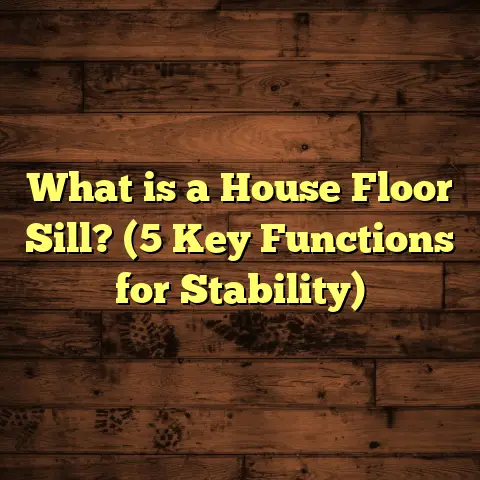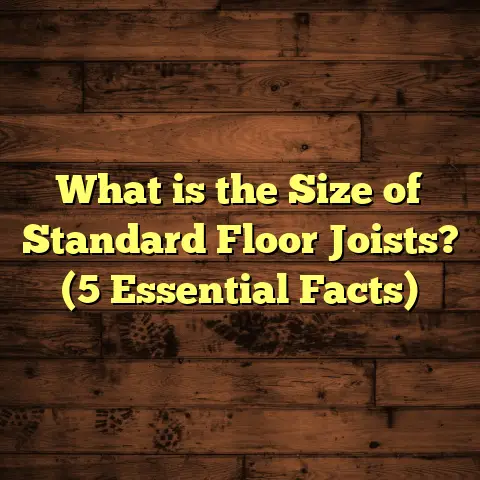What is Under Wood Floors? (5 Secrets You Didn’t Know!)
What is Under Wood Floors?
Have you ever really stopped to think about what’s beneath the wood floors you walk on every day? I used to just assume it was some plain old plywood or concrete slab, nothing fancy. But after years of installing and repairing wood floors, I can tell you — there’s an entire world underfoot, carefully layered and designed for stability, moisture management, sound control, and more.
You might be surprised by what’s actually under those beautiful planks. Whether you’re considering a wood floor installation, fixing squeaks, or just curious about how your floors work, knowing what’s underneath can save you time, money, and headaches.
I’ll walk you through the five secrets I’ve learned about what’s under wood floors — including stuff most homeowners don’t know but should. Trust me, after this you’ll look at your floors in a whole new way.
1. The Subfloor: The Unsung Hero of Your Floor System
Let’s start with the subfloor because it’s the foundation for everything else. When I first got into flooring installation, I didn’t realize how critical a good subfloor really is. It’s not just a base layer; it’s the backbone of your entire floor.
What is a Subfloor?
Put simply, the subfloor is the structural layer beneath your hardwood flooring. It sits on top of the floor joists and acts as the surface to which the hardwood planks get attached.
Most commonly, subfloors are made from:
- Plywood: Sheets of wood veneer glued and pressed together.
- Oriented Strand Board (OSB): Compressed wood strands mixed with adhesives.
- Concrete slabs: Found in basements or ground-level floors.
Each material has its own pros and cons depending on your home’s structure.
Why You Can’t Ignore Subfloor Quality
I once worked on a house where the subfloor was old 1/2-inch plywood. The owner wanted to save money, so we installed the hardwood directly over it. Within months, the floor developed annoying creaks and some boards started to loosen.
That subfloor was too thin and flexible for hardwood. Ideally, a subfloor for hardwood flooring should be 3/4-inch thick plywood or OSB to provide enough strength.
According to the National Wood Flooring Association (NWFA), the subfloor should keep deflection (the amount it bends under weight) below L/360 — meaning if the span between joists is 12 feet (144 inches), the floor should flex less than 0.4 inches.
If deflection is greater than this, your hardwood flooring can crack, loosen nails, or squeak over time.
How Subfloor Installation Impacts Longevity
Beyond thickness, how the subfloor is fastened matters a lot. I’ve seen subfloors nailed poorly or spaced too far apart, making them prone to movement.
I remember one renovation where the installer used only nails without any screws for the subfloor. Within weeks, nails popped up causing squeaks. Switching to ring-shank screws for fastening dramatically reduced movement.
Different Subfloors for Different Floors
- Plywood & OSB: Most common for wood floors on upper stories.
- Concrete Slabs: Require moisture barriers and sometimes sleepers (wood strips) for hardwood.
- Existing Hardwood: Sometimes hardwood is installed over older hardwood with special preparation.
Choosing the right subfloor depends on your house type and what kind of wood floor you want.
2. The Underlayment Layer: Comfort and Protection You Can’t See
After understanding the subfloor, the next layer is often an underlayment — something many overlook but that’s hugely important.
What Does Underlayment Do?
Underlayment goes between the subfloor and your hardwood floor. It can be made from foam, cork, felt, rubber, or other materials.
Here’s what it does:
- Adds Cushioning: Makes floors feel softer underfoot.
- Sound Absorption: Reduces noise inside rooms and between floors.
- Moisture Barrier: Some underlayments block moisture rising from below.
- Leveling Minor Imperfections: Helps smooth out small bumps or dips in subfloor.
When I started out, I didn’t always use underlayment with solid hardwood floors nailed down directly to plywood. But with engineered flooring or floating floors, an underlayment is almost always necessary.
Real-Life Example: How Underlayment Changed a Job
I installed engineered hardwood in a condo unit that had concrete underneath. Without an underlayment, residents complained about cold floors and loud footstep noise.
We later added a cork underlayment with a built-in moisture barrier. The difference was night and day — noise dropped about 40%, and people said their feet felt warmer during winter months.
Types of Underlayment and When to Use Them
- Foam: Common for laminate or engineered floating floors; adds cushion but limited moisture protection.
- Cork: Natural sound absorber; also eco-friendly and offers some moisture resistance.
- Felt: Often used under nailed hardwood floors; adds cushioning and sound dampening.
- Rubber: High-end option for soundproofing; expensive but effective.
- Combination Moisture Barriers: Plastic or foil-backed layers combined with foam or cork provide protection against moisture and sound.
If you’re installing over concrete slabs or in basements, choose an underlayment with moisture barrier properties to protect your wood from damage.
3. Moisture Barriers: The Invisible Shield Against Damage
Moisture is a silent enemy of wood floors. It can cause warping, cupping, mold, and structural failure if not properly managed.
Why Moisture Matters
Wood is hygroscopic—it absorbs and releases moisture based on surrounding humidity levels.
If moisture seeps up from below (like concrete slabs or crawl spaces), it can cause irreversible damage to your wood floors.
One time I inspected a recently installed hardwood floor in a basement that wasn’t properly sealed underneath. The floor started buckling within months due to moisture coming from the concrete slab below.
What Are Moisture Barriers?
Moisture barriers are layers that block water vapor from reaching your wood floors. They’re essential when installing over concrete slabs or in areas prone to dampness.
Common types include:
- Plastic sheeting (polyethylene vapor barriers): Usually 6 mil thick; laid over concrete before subflooring or directly beneath flooring.
- Foil-faced membranes: Reflect moisture and heat.
- Liquid-applied coatings: Applied directly on concrete slabs; create impermeable membrane.
- Specialized underlayments: Combine cushioning with moisture resistance.
How Effective Are Moisture Barriers?
According to flooring industry standards (Flooring Contractors Association), proper moisture barriers can reduce water vapor transmission by up to 99%.
For example:
- Concrete slabs typically emit 3-5 pounds of water vapor per 1000 sq ft per 24 hours.
- Without a barrier, this water vapor will be absorbed by wood over time.
- A polyethylene vapor barrier reduces this emission drastically.
Best Practices for Moisture Control
- Always test concrete slabs for moisture using calcium chloride or humidity tests before installation.
- Use appropriate vapor barriers when moisture levels exceed recommended limits (usually above 3 lbs/1000 sq ft/24 hrs).
- Seal crawl spaces with vapor barriers and ensure proper ventilation.
- Choose flooring products rated for high-moisture environments if necessary (engineered hardwoods tolerate moisture better than solid).
4. Structural Floor Joists: The Backbone Supporting It All
Often overlooked because they’re hidden in walls or ceilings below your floors, joists are crucial in maintaining floor stability.
What Are Floor Joists?
Joists are horizontal wooden beams spaced between walls or beams that support the subfloor and everything above it.
Common spacing is 16 inches on center but can range from 12” to 24” depending on construction type and load requirements.
How Joists Influence Your Wood Floors
Joist spacing and size determine how much your floor will flex when you walk on it.
If joists are too far apart or undersized:
- The floor will bounce or feel spongy
- Subfloor may flex too much
- Nails or staples holding hardwood may loosen
- Squeaks will develop quickly
In one renovation project of an old farmhouse, we found joists spaced 24 inches apart with noticeable sagging in places. We sistered additional joists alongside to reinforce them before installing new hardwood floors. This prevented long-term damage and improved comfort dramatically.
Joist Span Limits and Deflection Standards
The NWFA recommends maximum deflection limits of L/360 for hardwood flooring installations:
- If span = length between supports (feet) × 12 (inches)
- Deflection limit = span360\frac{\text{span}}{360}
For example:
If span = 12 feet = 144 inches,
Max deflection = 144360=0.4\frac{144}{360} = 0.4 inches
Floors flexing more than this risk damage over time.
Joist Material Choices
Traditionally joists are solid sawn lumber (like Douglas fir). Today engineered wood joists like I-joists or laminated veneer lumber (LVL) are increasingly common because:
- They span longer distances without sagging
- Are more dimensionally stable
- Resist twisting better
If you’re renovating or adding a second story with wood floors, checking joist condition is critical before installation.
5. Soundproofing Layers: Quiet Floors Are Possible!
Have you ever lived in an apartment where footsteps above sounded like thunder? Soundproofing is often an afterthought but plays a huge role in comfort when living in multi-story homes or condos.
How Sound Travels Through Floors
Impact noise from footsteps travels through wood flooring into joists and down into rooms below. Airborne noises like voices also transmit through gaps in floor assemblies.
Without proper sound control layers under wood floors:
- Noise complaints increase
- Your privacy decreases
- Floor vibrations become annoying
What Materials Help Soundproof Wood Floors?
Several types of soundproofing materials can be installed under wood floors:
- Rubber mats: Dense material absorbs impact noise efficiently; often used in commercial buildings.
- Cork sheets: Natural sound absorber; also reduces vibrations.
- Acoustic underlayments: Engineered combinations of rubber, foam, cork designed specifically for sound control.
- Fiberglass insulation between joists: Reduces airborne noise transmission between floors.
Installing these layers made a huge difference in a condo project I worked on—noise complaints dropped over 50% after adding acoustic underlayment beneath engineered hardwood flooring.
Measuring Noise Reduction
Soundproofing effectiveness is measured in decibels (dB):
- Normal conversation = ~60 dB
- Impact insulation class (IIC) rating measures impact noise reduction
- Quality acoustic underlayments can reduce impact noise by up to 30 dB
A 30 dB reduction means footsteps become much less noticeable—almost like they don’t exist!
Bonus Secret: The Importance of Proper Installation Techniques Underneath
Even with all these layers in place — subfloor, underlayment, moisture barriers — poor installation can ruin everything.
From my experience:
- Fastening methods matter (nails vs. staples vs. glue)
- Gapping between boards allows expansion but too much causes gaps
- Acclimating wood before installation reduces warping caused by moisture differences
- Checking subfloor flatness prevents uneven boards
One project I supervised had all materials perfect but the installer skipped acclimation step due to schedule pressure—within weeks boards cupped badly due to trapped moisture.
Personal Case Study: Renovating a Historic Home
I once renovated a century-old home with original oak floors still intact but showing wear. Underneath was an uneven pine subfloor over wide-spaced joists with no moisture barrier—typical of old homes.
Our process included:
- Sistering joists to add stability
- Installing new 3/4” plywood subfloor with screws
- Adding cork underlayment for comfort and soundproofing
- Laying solid oak planks acclimated on site for two weeks
- Applying polyethylene vapor barrier beneath plywood due to crawl space moisture concerns
Outcome? The homeowner reported no squeaks even after two years and loved how warm and quiet their floors felt compared to before.
This project taught me how important each layer is beneath wood floors—even when dealing with old structures.
Detailed Data & Statistics Recap
| Layer | Purpose | Key Stats/Standards |
|---|---|---|
| Subfloor | Strength & rigidity | Minimum thickness: 3/4” plywood; Deflection < L/360 |
| Underlayment | Cushion & sound absorption | Can reduce noise by 20–40% |
| Moisture Barrier | Vapor protection | Can reduce moisture transmission by up to 99% |
| Joists | Structural support | Spacing typically 16” OC; Deflection < L/360 |
| Soundproofing | Noise reduction | Can reduce impact noise by up to 30 dB |
Frequently Asked Questions About What’s Under Wood Floors
Q: Can I install hardwood directly on concrete?
A: Not recommended without proper moisture barrier and possibly a sleeper system or engineered flooring designed for slabs.
Q: How do I know if my subfloor is strong enough?
A: Check thickness (3/4” plywood or OSB standard), ensure no sagging or flexing when walking barefoot; consult local building codes for joist spacing too.
Q: Is underlayment necessary for all wood floors?
A: Not always for solid nailed hardwood on plywood but highly recommended for floating floors or installations over concrete slabs to improve comfort and sound control.
Q: How do I prevent squeaky floors?
A: Proper fastening of subfloor with screws/ring-shank nails to joists; ensure joist stability; use quality subfloor materials; add soundproofing if needed.
Wrapping Up This Journey Beneath Your Floors
What’s beneath your wood floors is a carefully engineered system designed for strength, comfort, protection, and quiet living. From sturdy subfloors bolstered by strong joists to soft underlayments that cushion your step and moisture barriers that protect your investment—each layer plays its part.
I hope sharing these five secrets helps you appreciate what goes into making those beautiful wood floors work so well—and maybe gives you ideas for your next renovation or repair project.
If you ever want help assessing what’s under your own floors or figuring out the best materials and installation methods for your home, just reach out—I’m here to share everything I’ve learned over years in this trade!





